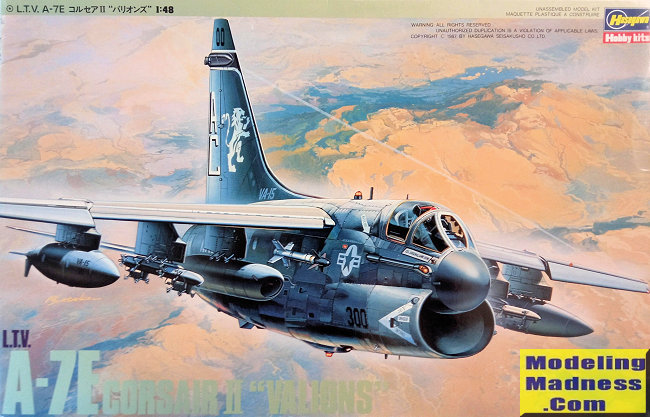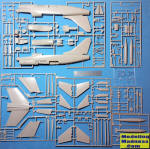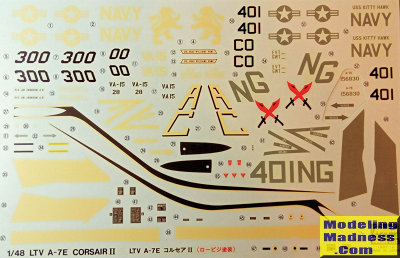
| KIT #: | 07014 (P14) |
| PRICE: | $50.00 or so when new |
| DECALS: | Two options |
| REVIEWER: | Spiros Pendedekas |
| NOTES: | Still an excellent (though not “shake and bake”) kit |

| HISTORY |
The A-7 Corsair II is an American carrier-capable subsonic
light attack aircraft, developed during the early 1960s as a replacement for the
A-4 Skyhawk. In many respects a simpler, cheaper and subsonic F-8 Crusader, the
so called SLUF (Short Little Ugly Fellow) first flew on 26 September 1965 and
entered squadron service with the USN on 1 February 1967. By the end of that
year, the type was being deployed overseas for the Vietnam War.
Initially adopted by the
USN, the A-7 proved equally attractive to other services, soon being adopted by
the USAF and the Air National Guard (ANG) to replace their aging Skyraider and
Super Sabre fleets. Improved models of the A-7 would be developed, typically
featuring more powerful engines and increasingly capable avionics.
American A-7s would be used in various major conflicts,
including the Invasion of Grenada, Operation El Dorado Canyon and the Gulf War.
The type was also used to support the development of the F-117 Nighthawk.
The type would be exported to Greece in the 1970s and to
Portugal in the late 1980s. The USAF and USN opted to retire their remaining
examples in 1991, followed by the ANG in 1993, the Portuguese Air Force in 1999
and, finally, the Hellenic Air Force in 2014.
| THE KIT |
 It was the year 1987 when Hasegawa decided to treat the
modeling world with a state of the art quarter scale A-7 that would by far
supersede the older Aurora/Monogram and Esci offerings, not only in details
offered, but also in overall accuracy. The kit was offered in the standard "E"
and the Air Force ”D” version, the latter featuring different main wheels, no
nose gear launch bar and piston and some other differences, which were taken
care of the usual Hasegawa approach by providing common sprues fo the “base”
model, with extra sprues to cater for the different versions.
It was the year 1987 when Hasegawa decided to treat the
modeling world with a state of the art quarter scale A-7 that would by far
supersede the older Aurora/Monogram and Esci offerings, not only in details
offered, but also in overall accuracy. The kit was offered in the standard "E"
and the Air Force ”D” version, the latter featuring different main wheels, no
nose gear launch bar and piston and some other differences, which were taken
care of the usual Hasegawa approach by providing common sprues fo the “base”
model, with extra sprues to cater for the different versions.
Typically for Hasegawa,
the kit has been regularly reissued ever since (another 15 times so far) with
very nice schemes (one being a Revell reboxing), with the 2010 issue containing
all sprues to make either versions. The specific kit was the initial 1993 "E"
Vallions edition, bought around 2003 from my usual hobby shop in Athens, the
usual beloved way, i.e. bargain the price and pay cash. It came in the excellent
Hasegawa-style (big) top opening box, featuring an extremely attractive box art
by Koike Shigeo, portraying VA-15's #157586, seemingly the CO’s bird.
Upon opening the box, I was greeted with 200 light gray
styrene parts, arranged in 10 sprues of various sizes, all of them bagged
together, meaning potential scratches. At least the clear sprue is separately
bagged. Molding is crisp with minimal flash. Detail is mostly engraved (raised
where "needed", i.e. door innards rivets), looking very convincing. I found a
few ejector pin marks at visible places (something not unexpected back in 1987),
with some of them not too easy to remove.
Cockpit is well appointed
with a nice instrument panel and side consoles, all featuring molded-on details,
two types of very convincing seats (early Escapac 1G-2 or late SGU-8A) for the
two different kit schemes, stick, rudder pedals and a busy looking rear
bulkhead. A good looking pilot is also provided, together with the distinctive
ladder and steps that can be posed extended. Though one can never super-detail
too much the prominent, spacious and busy-looking A-7 cockpit, the kit provided
will be sufficient for a good number of us, the only thing really missing being
the seat belts (if you decide not to attach the pilot).
Landing gear is very well represented, with the bays
looking pleasantly busy and the wheels looking realistic. I would not mind
having brake lines, either molded onto the main legs or separately provided.
The air intake, a most prominent feature of the A-7, is
provided as 2 pieces longitudinally split. While it looks nice and deep, the
modeler will have to address the inevitable seams (or go for a seamless
aftermarket one, which, typically, will require an amount of effort to fit). The
tail pipe looks good, with an equally good looking turbine face to be affixed at
its rear end. Its lack of depth, compared to the real thing, will practically be
hard to notice after receiving its blackish burned metal color.
The distinctive air brake is equally well represented and
can be posed open (this happens only in flight, though, as it is always closed
when on the ground - it is too long to deploy, anyway). The equipment bays side
doors can be attached “open”, so the very nice internal details provided can be
seen and the same is true for the Ram Air Turbine (RAT), which can be posed
“deployed”.
The wings feature separate slats and flaps that can be
attached “down” (rarely seen on the ground this way, though) and outer wing
sections that can be posed folded with believable hinge detail.
A PE fret is provided, containing base plates for the probe
and some external plumbing bilaterally of the fuselage. It is of the hard
stainless steel type and does not seem too easy to use.
Regarding external stores,
the (practically always carried) six underwing and (not that often attached) two
fuselage mounted pylons are provided, looking very nice. Two realistically
looking Multiple Ejector Racks (MER) are supplied, together with an equally good
looking pair of wing tanks, a Forward Looking Infra Red (FLIR) pod (rarely
carried but very distinctive looking) and two Sidewinders for the fuselage
pylons. Nothing else is provided, with the builder who will decide to load the
prime candidate for loading A-7 having to buy the ordnance separately, per the,
again, usual and, at this case, not too favorable Hasegawa practice.
Clear parts are superbly
molded and crystal clear. Instructions come to the usual and excellent Hasegawa
pamphlet style, containing a short history of the type, a parts list, with the
construction spread in 14 followable and logical steps with all positionable
items options clearly indicated. Color callouts are thoroughly provided during
assembly, in Gunze Sangyo /Mr Color codes and also in generic form.
 Two overall gray schemes
are provided, for the boxart VA-15 “Valions” and a VA-147 “Argonauts" bird.
Though overall gray might sound monotonous, I personally find the particular
schemes attractive, emphasizing the Corsair's distinctive looks. Decals are tad
thick but very well printed and contain a vivid amount of maintenance sencilling,
however the white is represented as “ivory”. They seem to be in excellent
condition despite being old. Typically for Hasegawa decals of the era, they are
expected to take ages to detach from their backing paper, but to behave well
afterwards.
Two overall gray schemes
are provided, for the boxart VA-15 “Valions” and a VA-147 “Argonauts" bird.
Though overall gray might sound monotonous, I personally find the particular
schemes attractive, emphasizing the Corsair's distinctive looks. Decals are tad
thick but very well printed and contain a vivid amount of maintenance sencilling,
however the white is represented as “ivory”. They seem to be in excellent
condition despite being old. Typically for Hasegawa decals of the era, they are
expected to take ages to detach from their backing paper, but to behave well
afterwards.
Instructions want you to first assemble the cockpit, pilot
included, where you have to choose the correct seat for your chosen scheme. The
intake with the nose bay attached underneath is then to be assembled, followed
by the tail pipe, with all above subassemblies, plus the main instrument panel
and shade, trapped between the fuselage halves onto which some holes must have
been beforehand predrilled.
The distinctive air brake is then assembled and attached,
followed by the rudder base, bay doors, RAT, refueling probe and fuselage
plumbing. Landing gear assembly and installation is next, with the fuselage
mounted Sidewinders with their pylons to follow. Construction then moves onto
main wing assembly and installation, followed by the elevators and
transparencies.
Last step includes assembly and installation of the six
wing pylons, the two external tanks, the FLIR pod and the two MERs, with an
external stores diagram provided should you wish to load your A-7 (after, of
course, having bought the separately sold ordnance...). Obviously, the build
presents a certain level of complexity, requiring more than novice skills.
| CONCLUSIONS |
As of 2022, this is still a very comprehensive kit of the
iconic A-7. Molding, especially in my initial release, is excellent, general
shape looks correct and details are generously provided with many parts
optionally posed "open" or "deployed". Clear parts look great, decals are
relatively thick, with the white represented as ivory, but are well printed and
look still in excellent condition, instructions are clear and the box offered
schemes are appealing.
Though not "shake and bake", it is definitely a buildable
kit and probably still the most accurate representation of the real thing, with
the final result being very charming, as you can admire the completed models at
the MM archives reviews. If you are not a novice modeler, this is a kit worth
tackling.
Happy modeling!
Spiros Pendedekas
August 2022
Copyright ModelingMadness.com. All rights reserved. No
reproduction in part or in whole without express permission.
If you would like your product reviewed fairly and
fairly quickly, please
contact
the editor or see other details in the
Note to
Contributors.